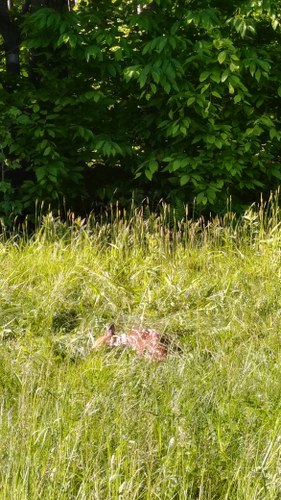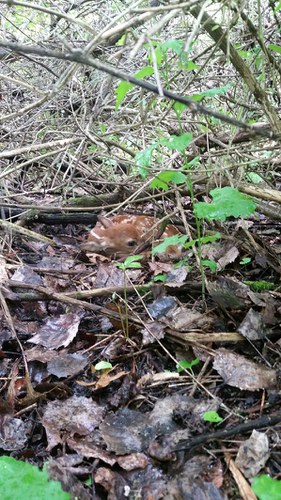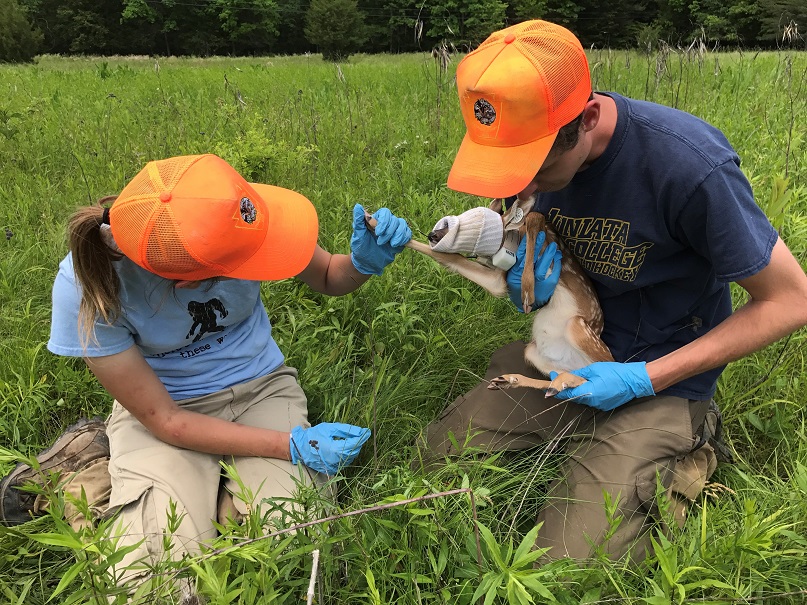[Comment in brackets are by Jeannine and Duane]
From the Northern Crew:
Hi All,
This was another exciting week for the Northern Crew. We started out with our first fawn mortality investigation. Although we were all sad to experience our first mortality, this one at least proved an interesting investigation!
The crew and I (accompanied by M.S. student Tess Gingery) put our telemetry skills to the test while hiking in the rain towards the direction of the VHF signal. Despite the signal being inconsistent, with great team work and perseverance we successfully located the collar, ear tags, and carcass. The remains of the fawn were buried beneath ~8 inches of soil and leaf litter.
This was probably a huge reason why the signal was inconsistent and weak even when we were fairly close! A cache like this, with the head still connected to the neck, is a great indicator that this may have been a bobcat kill. However, a necropsy [and DNA] will be the best way to know for sure.
Unfortunately, no tracks or scat were found near the cache pile.
Later on in the week we had another amazing capture day resulting in three fawns in one day!
One fawn capture may have been from a VIT doe, although we are not positive because earlier in the season we had to blow off the doe’s collar when it stopped communicating with the satellites. But after dropping the doe’s collar, we have been monitoring her VIT to hear if it was expelled or not. On Thursday, we checked and it was out!

We found the fawn near where her collar was recovered and close enough to where we found the VIT to make a reasonable assumption that it could be the VIT doe’s fawn. We were not able to see if the doe (who made an appearance during the fawn’s workup) had ear tags or not but if we had it would have settled the matter [but with tissue samples we can do DNA analyses to confirm].
In addition, we had another mortality this week. We currently have 21 living fawns, but have captured 23 in total this season.
-Maureen
Field Crew Leader
PGC Deer and Elk Section
——————————————————————-
From the Southern Crew:
Hello All,
We captured 13 fawns this week, bringing our total to 19 captures. We had a five-fawn-day this week, as well!
One VIT was expelled on Memorial Day, but it wasn’t until 8:30 PM, so we saved the search for early Tuesday morning. I was very excited for this adventure considering this was the trap-happy doe from this past winter.
We had planned to meet near where the doe was captured until I checked her recent locations. She had moved roughly 6-6.5 miles from her winter home range to her fawning area! [we have had other females do this – check out this story]
As we neared the birth site, it began to look hopeless.
She gave birth in a thicket – we’re talking multiflora rose, barberry, autumn-olive, and honeysuckle. We searched and searched.
Eventually, I decided to walk in on the doe using the telemetry equipment. I was nearly on top of her, but couldn’t see her in the middle of the thickest thicket possible and, as usual, she was just out of sight. I did find her bed site, however, and fresh scat.
She was only 50 meters from the birth site, so I thought we’d better search the thicket near the birth site again.
Sure enough, Avery whispered “Fawn!”
T here she was, only meters from the birth site and tucked far into the thicket. We weren’t even sure how she got back there, but it was awesome. Her name should be “Rose” given the shrubbery where we found her. Hardly 12 hours old and already a wild one (like mother, like daughter) — bleating, kicking, and she was trying to nurse on my jacket and Ben’s hand.
here she was, only meters from the birth site and tucked far into the thicket. We weren’t even sure how she got back there, but it was awesome. Her name should be “Rose” given the shrubbery where we found her. Hardly 12 hours old and already a wild one (like mother, like daughter) — bleating, kicking, and she was trying to nurse on my jacket and Ben’s hand.
On the other side of life, we had a VIT fawn mortality in Rothrock State Forest on Memorial Day (handled by Amber and Nick). We caught the fawn this past week in a crazy rain storm. The crew found 4 separate piles of chewed on bones within a few meters of each other and other indications that it was a potential bear kill [but will not be confirmed until all evidence is assessed]
We also lost a fawn over the weekend. He was curled up, as if he were sleeping, and there were no signs of predation. He was underweight and his ribs were protruding. He had only moved about 20 meters from his original capture site and the crew noted that he seemed lethargic when they captured him. They were actually processing a different fawn when they heard him bleating nearby.
We were tipped off to some potential fawn captures by the public and one of those tips did result in a capture. The crew also watched a fight between two male groundhogs.
Fawns are getting bigger and many are running now!
Field Crew Leader
If you would like to receive email alerts of new blog posts, subscribe here.
And Follow us on Twitter @WTDresearch

